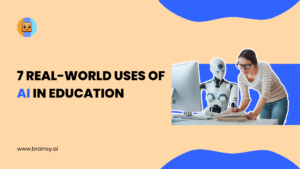
Artificial Intelligence (AI) has been a buzzword in various industries, and the education sector is no exception. AI has been transforming the way educators teach and students learn, providing new opportunities for personalized learning and improving educational outcomes. However, despite the potential benefits of AI in education, some concerns have been raised about its implementation. Critics argue that AI may replace human teachers, exacerbate inequalities in education, and compromise student privacy. Addressing these concerns is crucial to ensure that AI is used ethically and effectively in education.
In this blog post, we will explore the benefits and criticisms of AI in education and discuss how transparency and accountability measures can address concerns about its implementation. Additionally, we will introduce Brainsy AI as a solution for ethical AI in education.
Benefits of AI in Education
Artificial Intelligence (AI) has been making significant strides in the field of education. With the help of machine learning algorithms and natural language processing, AI can be used to create personalized learning experiences for students, automate grading, adapt learning materials based on student progress, and assist students with disabilities. In this section, we will explore each benefit in detail.
Personalized Learning
One of the most significant benefits of AI in education is personalized learning. Personalized learning refers to tailoring the learning experience to individual students’ needs and abilities. AI can analyze data about a student’s performance, behavior, and preferences to create a customized curriculum that suits their unique requirements.
For instance, Carnegie Learning uses AI-powered software to provide math instruction that adapts to each student’s strengths and weaknesses. The software tracks each student’s progress and provides feedback on where they need improvement. It then generates individualized lessons that address those areas.
Similarly, Duolingo uses an AI-based algorithm to personalize language learning courses for its users. The app analyzes user data such as their proficiency level and preferred method of learning (visual or auditory) to create a customized curriculum that suits their needs.
Efficient Grading
Grading is a time-consuming process for teachers who have to evaluate assignments manually. However, with the help of AI-powered tools like Gradescope, teachers can grade assignments efficiently while also providing immediate feedback.
Gradescope uses computer vision technology to grade paper-based assignments quickly. Teachers upload scanned copies of assignments into the system, which then identifies answers and assigns points accordingly. This saves valuable time for teachers who can now focus on creating better lesson plans instead of grading papers.
Similarly, Turnitin uses machine learning algorithms to detect plagiarism in student submissions automatically. This ensures academic integrity while also saving time for teachers who would otherwise have had to check every submission manually.
Learn more about Brainsys Grading features.
Adaptive Learning
Adaptive Learning refers to adjusting the difficulty level of learning materials based on a student’s progress. With the help of AI-powered algorithms like Knewton, adaptive learning is now possible at scale.
Knewton analyzes data from millions of students worldwide to identify patterns in how they learn best. Based on this information, it creates personalized study plans for each student that adapt as they progress through their coursework.
For example, if a student struggles with geometry but excels at algebraic equations, Knewton will adjust their lessons accordingly by providing more practice problems related to geometry or reducing them altogether while focusing more on algebraic equations.
Finally, AI can assist students with disabilities by providing them with tools that make it easier for them to learn effectively. For example:
Improved Accessibility
- Google Translate helps non-native speakers understand course material by translating it into their native language.
- Speech recognition software like Dragon Naturally Speaking allows students with physical disabilities to dictate written work instead of typing it.
- Text-to-speech software like Kurzweil 3000 reads text aloud for visually impaired students.
Criticisms of AI in Education
As with any new technology, AI in education has faced criticisms and concerns. It is important to address these issues to ensure that the implementation of AI in education is ethical and beneficial for all students.
Bias and Discrimination
One of the main concerns with AI in education is the potential for perpetuating existing biases and discrimination. Since AI algorithms are only as unbiased as their creators, it is crucial to ensure that they are developed with diversity and inclusivity in mind. Examples of bias and discrimination in AI in education include algorithms that disproportionately punish students of color or those from low-income backgrounds.
Privacy Concerns
Another concern with AI in education is student privacy. With the collection and analysis of large amounts of data, there is a risk that sensitive information could be compromised. It is important for schools and edtech companies to have strong privacy policies and protocols in place to protect student data. Examples of privacy breaches in AI in education include unauthorized access to student records or sharing data with third-party vendors without consent.
Lack of Human Interaction
AI can also limit human interaction and social skills development, which are essential for personal growth and success outside of the classroom. While some argue that AI can supplement human instruction, others worry that it will replace teachers altogether. Research has shown that excessive screen time can negatively impact children’s cognitive development, making it important to strike a balance between technology use and face-to-face interaction.
Overreliance of Technology
Finally, there is a concern about overreliance on technology at the expense of other important skills such as critical thinking, problem-solving, creativity, and communication. While AI can help automate routine tasks or provide personalized learning experiences, it cannot replace human intuition or judgement entirely. Students need opportunities to develop these skills through hands-on activities, group projects, discussions, and other forms of active learning.
In summary, while there are valid criticisms about the use of AI in education, it is possible to address these concerns through transparency and accountability measures. By prioritizing diversity, inclusion, privacy protection, human interaction, and holistic skill development when designing AI systems for education purposes; we can ensure that students receive equitable access to high-quality learning experiences regardless of their background or abilities.
Addressing Concerns through Transparency and Accountability Measures
As the use of AI in education continues to grow, concerns about the transparency and accountability of these algorithms have become more prevalent. To address these concerns, it is important to ensure that AI algorithms used in education are transparent and understandable to educators, parents, and students alike. This means that the process by which AI systems make decisions must be clear and easy to follow. For example, some AI algorithms in education use decision trees or other visual aids to help users understand how a decision was made.
In addition to transparency, ethical guidelines for AI in education are necessary to ensure that these systems are being used responsibly. Ethical guidelines can help prevent bias and discrimination in decision-making processes, as well as protect student privacy. Some examples of ethical guidelines for AI in education include requiring informed consent from students and parents before using their data for machine learning purposes, as well as regularly auditing the algorithms used to ensure they are fair and unbiased.
Finally, accountability measures for AI in education must be put in place to ensure that these systems are being used appropriately. This includes regular testing of the algorithms used to ensure they are functioning as intended, as well as providing a clear path for recourse if something goes wrong. For example, if a student is unfairly penalized by an AI algorithm, there should be a process by which they can appeal the decision and have it reviewed by a human educator.
By implementing transparency and accountability measures for AI in education, we can address many of the concerns surrounding these technologies. At Brainsy AI, we take this responsibility seriously and work hard to ensure that our algorithms are transparent, ethical, and accountable. By doing so, we hope to build trust with educators, parents, and students alike and pave the way for a brighter future in education technology.
Brainsy AI: A Solution for Ethical AI in Education
As concerns about the ethical implications of AI in education continue to grow, Brainsy AI offers a promising solution. Brainsy AI is an innovative platform that utilizes machine learning and data analytics to personalize learning experiences for students. Unlike other AI systems, Brainsy AI prioritizes transparency, accountability, and student privacy.
What is Brainsy AI?
At its core, Brainsy AI is a platform that leverages data-driven insights to improve student outcomes. By analyzing data on student performance and engagement, Brainsy AI can identify areas where students are struggling and provide personalized support. The platform also offers tools for teachers to create customized lesson plans and assessments based on individual student needs.
How Brainsy AI Addresses Concerns About AI in Education
One of the main concerns about AI in education is the potential for bias and discrimination. However, Brainsy AI addresses this issue through a commitment to transparency and accountability. The platform provides detailed reports on how it makes decisions about student learning and progress, allowing teachers and administrators to monitor its actions. Additionally, Brainsy AI uses best practices for data privacy, ensuring that student information is protected at all times.
Another concern about the use of technology in education is the potential loss of human interaction. However, with Brainsy AI, technology is used as a tool to enhance teacher-student interactions rather than replace them. By providing teachers with real-time insights into student performance, they can better understand their students’ needs and offer more effective support.
In conclusion, AI has the potential to revolutionize education by providing personalized learning experiences and improving student outcomes. However, there are valid concerns about the ethical implications of using AI in education, such as data privacy and algorithmic bias. It is essential to address these concerns through transparency and accountability measures that ensure the responsible use of AI technology.
Brainsy AI is a solution that provides ethical AI in education by offering transparent algorithms and data privacy protection. By implementing such solutions, we can harness the power of AI to improve education while ensuring that it aligns with our values and principles. As educators, parents, and students, we have a responsibility to advocate for ethical AI in education and demand transparency from those who develop and implement it. With these efforts, we can create a future where AI enhances our educational experiences without compromising our privacy or perpetuating discrimination.





